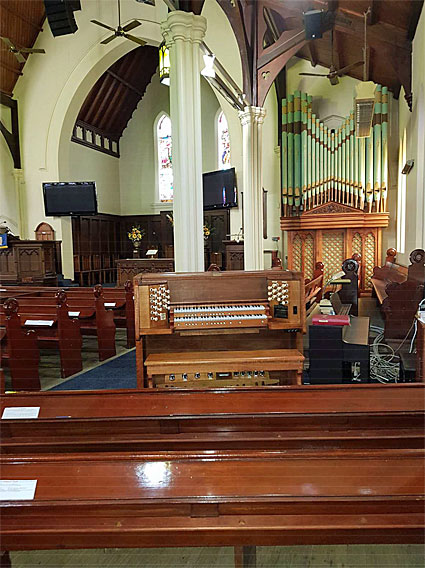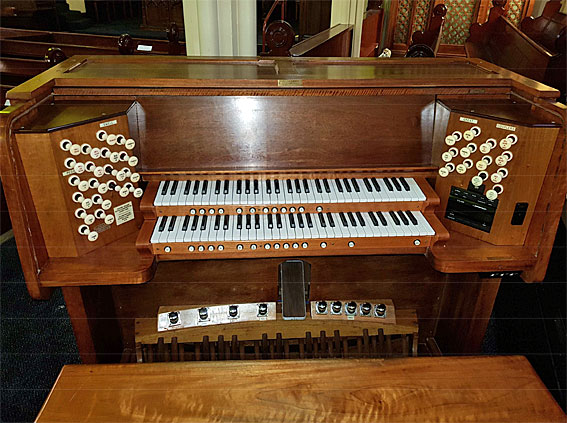
St Paul's Presbyterian Church organ
[photo: Ian Brown June 2018]

St Paul's Presbyterian Church organ
[photo: Ian Brown June 2018]
Ian D. Brown and Associates June 2018 Newsletter:
Floodwater and contaminants entered the Church just over a year ago. The organ console is able to be lifted up by placing a steel frame over the top and bolting this to specially prepared hidden nuts within the end console frames. A chain block above lifts the console up into the roof. The pedal board and bench are taken away. This has occurred previously on numerous occasions. This time one of the bolts was missing. It was too late to drive over to Bunnings for another. The flood rose to just below keyboard level. After the flood they hosed out inside the console and although after drying, most of the organ did work again, there was still significant long term damage done to the banks of multi-contact switches and relays and over further time many more problems have emerged. We quoted for repairs and the insurance claim was accepted. Unlike the Uniting Church, the Presbyterians made a more honest decision and decided to spend the money to have the organ repaired. As part of the process, we thought that our proposal for repairs would have greater acceptance to an insurer if all that connected to the console was an extension lead and an 8 wire data cable. This would be easier to disconnect quickly than a cable of 250 wires plus heavy red and black 12v wires and 240v power. So as I write this we have repaired all of the woodwork and are in the final stage of installing the new operating system in this console. The new system is capable of far more than just connecting keys and stops to play the organ and will provide the Church with many more new features than they might actually use. The new keyboards are provided with extra thumb pistons including reverser pistons for the three main couplers. The system has a sequencer so for this there are "Next" and "Previous" pistons provided. You can set up to play a piece of music requiring many combination changes. When playing the piece, you just keep pressing the "Next" piston and the next set combination of stops will appear. There are now 8 general pistons. A local supervisor can allocate a "folder" in the system to a visiting organist who enters a password to access this folder at any time. Within that folder there are 50 channels for the piston and sequencer system. A USB port on the console enables all piston selections to be taken away from the organ on a flash drive. For times when an organist is unable to be present at a Service, all of the music can be played and recorded and stored to a flash drive or the system memory to be played "song" by "song" later by the organ exactly as recorded. There are so many features that the users manual is a 1/2 inch thick A4 book. Two extra stop knobs have been provided for "Auto Bass" where the lowest note on the Great automatically plays selected pedal stops. Also a stop we have called "Swell Solo on Great". If you pull out, say Open Diapason 8 and Principal 4 on Great and stops on Swell including the (loud) Cornopean 8, and use this stop, the highest note of any chord played on Great will also play on the Swell. This has the advantage of giving the solo note as if played on the Swell but without losing the extra weight of the note played on the Great.

St Paul's Presbyterian Church organ console
[photo: Ian Brown June 2018]